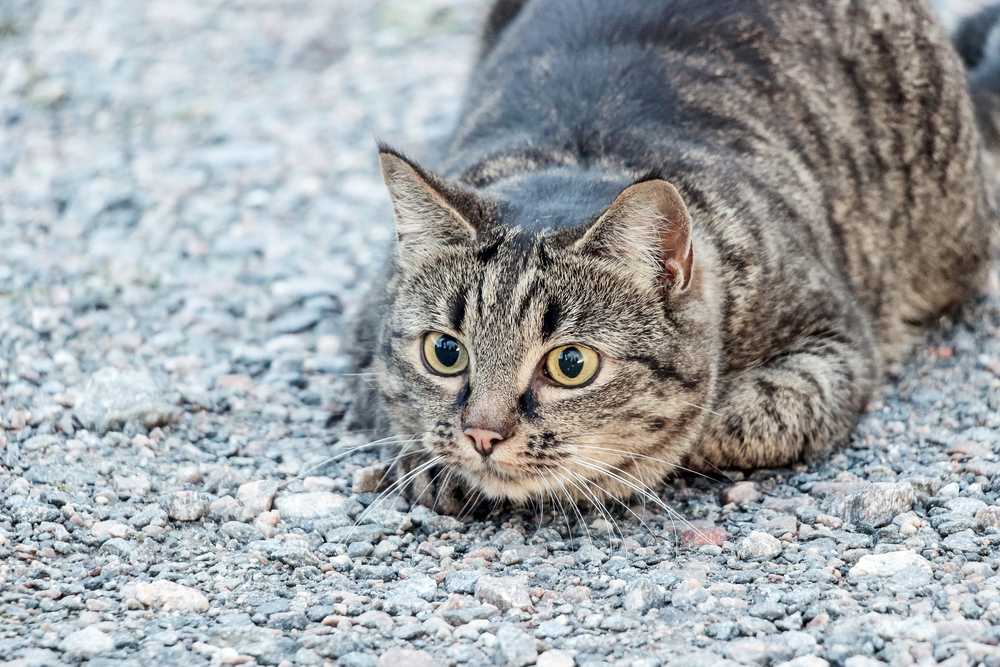
When athletes perform it has a certain degree of ritual about it. For example, each tennis serve is usually preempted with a meticulous routine: adjust their shirt, inspect the tennis balls, hop from foot to foot, and bounce the ball a set number of times. It all serves as preparation for the play to come, both for the body and the mind.
Cats are athletic. They spring, pounce, jump, and land with often precision and accuracy. Like the tennis player, they have their own rituals before they leap into action. Typically they crouch down low with their belly flat to the floor and rear end in the air.
Both domestic cats and big cats have a characteristic butt wiggle they perform before springing into action and pouncing. This endearing feline behavior most likely provides a physical preparation for the cat’s pounce and serves as a form of warm up for the activity. It is thought that the rear end twitching is also a physical expression of emotions of excitement, focus, and anticipation.Key Takeaways
A steely look of determination and focus settles on the intended “prey,” be this unsuspecting wildlife, their favorite cat toy, or your feet! As the upper body remains motionless, the hind legs flex in turn and create a little butt shimmy. We see this behavior right across the cat kingdom as wild cats are often seen doing the same thing pre-pounce.
Reasons for the Pre-Pounce Cat Wiggle
The exact reasons for this particular cat behavior are not proven but are thought to include:
1. Muscle Warmup
A pounce is an explosive movement where lots of power is transferred through the cat’s hind limbs in order to propel them forwards. Much like serving an ace, pouncing requires a high level of muscular effort, and muscles perform best when already warmed up. Wiggling the back legs increases blood flow and increases muscle efficiency.
The fact that big cats such as lions, tigers, and jaguars use the same technique leads us to think this wiggle action increases the chance of a successful pounce when prey is involved because adult wild cats will rarely expend energy unnecessarily.
2. Improved Traction and Proprioception

Wiggling the back end might help get the cat’s front paws into the ideal position.
John Hutchinson is a professor of evolutionary biomechanics at the Royal Veterinary College in London. He theorizes that the hind limb wiggle presses the cat’s paws into the ground and increases friction. This improves the traction through the back legs and improves the chances of a successful pounce, much like wearing special sports shoes with a functional tread would improve our grip during sport.
Professor Hutchinson also believes that the butt wiggle confers a proprioceptive advantage as well. Proprioception is an animal’s ability to know where its limbs are in space and its awareness of its own body’s movement. By jiggling the back legs, cats are increasing the neural commands to the rear end and improving its proprioception, and improving the pounce.
3. Emotional Response
There are undeniable physical reasons for cats to partake in a pre-pounce butt shimmy, but it might partly be an emotional response as well. Some cats and particularly kittens enjoy playing, hunting, or pouncing more than others, but typically it is a pleasurable cat behavior.
When cats, or any animal, engage in a behavior they enjoy, the body releases dopamine, the “happy hormone.” Dopamine creates feelings of pleasure and satisfaction. While engrossed in the thrill of the hunt, it is possible that the dopamine surge pushes cats to create their butt wiggle.
In this way, the wiggle is a physical manifestation of an emotional response. Much like cats kneading when they are happy and receiving cuddles, the butt wiggle might be a subconscious expression of how they are feeling.
Final Thoughts

A cat’s pre-pounce wiggle is likely a warmup for the big event, as well as a sign they are excited.
The pre-pounce butt wiggle is predictably repeated time and time again across the feline kingdom. So much so, it must serve a purpose. Although behaviorists are uncertain as to its primary function, it likely serves to improve traction as well as muscle and nerve function readiness ahead of the pounce.
Additionally, it is probably a sign of our cats’ emotions brimming over and a sign that they are happy and excited. For cat owners, happy, excited cats are the prerogative, so embrace that endearing butt shimmy!
Also Read: How Do Cats Hunt?
Frequently Asked Questions
Why does my cat wiggle before attacking?
It is thought that cats wiggle their rear end before attacking in order to warm up their muscles, focus their attention, and improve the traction to help them pounce. It might also be a sign of their pleasure and excitement at the chance to hunt or play.
Do big cats wiggle before pouncing?
Yes, big cats including lions, tigers, and jaguars often wiggle their rear end before pouncing. It is thought the warm-up movement helps increase their chance of a successful pounce and helps them catch prey. It is a cat behavior that is shared between both big cats and their domestic counterparts.
Why do cats pounce on you?
Cats instinctively want to practice hunting as this is how their wild cat ancestors would have had to survive. Domestic cats have retained and enjoy this behavior and will often pounce as a form of play because they find it fun.







